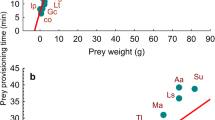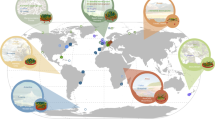Abstract
Species in the mammalian order Carnivora exhibit a huge diversity of life histories with body sizes spanning more than three orders of magnitude. Despite this diversity, most terrestrial carnivores can be classified as either feeding on invertebrates and small vertebrates or on large vertebrates. Small carnivores feed predominantly on invertebrates probably because they are a superabundant resource (sometimes 90% of animal biomass1,2,3); however, intake rates of invertebrate feeders are low, about one tenth of those of vertebrate feeders4,5. Although small carnivores can subsist on this diet because of low absolute energy requirements, invertebrate feeding appears to be unsustainable for larger carnivores. Here we show, by reviewing the most common live prey in carnivore diets, that there is a striking transition from feeding on small prey (less than half of predator mass) to large prey (near predator mass), occurring at predator masses of 21.5–25 kg. We test the hypothesis that this dichotomy is the consequence of mass-related energetic requirements and we determine the predicted maximum mass that an invertebrate diet can sustain. Using a simple energetic model and known invertebrate intake rates, we predict a maximum sustainable mass of 21.5 kg, which matches the point where predators shift from small to large prey.
This is a preview of subscription content, access via your institution
Access options
Subscribe to this journal
Receive 51 print issues and online access
$199.00 per year
only $3.90 per issue
Buy this article
- Purchase on Springer Link
- Instant access to full article PDF
Prices may be subject to local taxes which are calculated during checkout



Similar content being viewed by others
References
Wilson,E. O. The little things that run the world: the importance of conservation of invertebrates. Conserv. Biol. 1, 344–346 (1987).
Wilson,E. O. Success and Dominance in Ecosystems: the Case of Social Insects. (Ecology Institute, Olendorf, Luhe, Germany, 1990).
May,R. M. How many species are there on earth? Science 241, 1441–1449 (1988).
Waser,P. M. Small nocturnal carnivores: ecological studies in the Serengeti. Afr. J. Ecol. 18, 167–185 (1980).
Schaller,G. B. The Serengeti Lion: a Study of Predator–Prey Relations 1–480 (Univ. Chicago Press, Chicago, 1972).
Purvis,A. & Rambaut,A. Comparative analysis by independent contrasts: an Apple Macintosh application for analysing comparative data. Comput. Appls. Biosci. 11, 247–251 (1995).
Bininda-Edmonds,O. R. P., Gittleman,J. L. & Purvis,A. Building large trees by combining phylogenetic information: a complete phylogeny of the extant Carnivora (Mammalia). Biol. Rev. 74, 143–175 (1994).
Gorman,M. L., Mills,M. G., Raath,J. P. & Speakman,J. R. High hunting costs make African wild dogs vulnerable to kleptoparasitism by hyaenas. Nature 391, 479–481 (1998).
Schmidt-Nielsen. Scaling: Why Is Animal Size So Important? 1–241 (Cambridge Univ. Press, Cambridge, 1984).
Taylor,C. R., Heglund,N. C. & Maloiy,G. M. O. Energetics and mechanics of terrestrial locomotion. I. Metabolic energy consumption as a function of speed and body size in birds and mammals. J. Exp. Biol. 97, 1–21 (1982).
Richardson,P. R. K. Food-consumption and seasonal-variation in the diet of the Aardwolf Proteles-Cristatus in Southern-Africa. Z. Saugetierk. 52, 307–325 (1987).
Skinner,J. D. & Smithers,R. H. N. Mammals of the Southern African Subregion (Univ. Pretoria, South Africa, 1990).
Kruuk,H. The Social Badger (Oxford Univ. Press, Oxford, 1989).
Malcolm,J. R. Socio-ecology of bat-eared foxes, Otocyon megalotis. J. Zool. Lond. 208, 743–744 (1986).
Williams,J. B., Anderson,M. D., Richardson,P. R. K. Seasonal differences in field metabolism, water requirements, and foraging behavior of free-living aardwolves. Ecology 78, 2588–2602 (1997).
Rood,J. P. Population dynamics and food habits of banded mongoose. E. Afr. Wildl. J. 13, 89–111 (1975).
Lamprecht,J. On diet, foraging behaviour and interspecific food competition of jackals in the Serengeti National Park, East Africa. Z. Saugetierk. 43, 210–223 (1978).
Macdonald,D. W. The Red Fox, Vulpes vulpes, as a predator upon earthworms, Mumbricus terrestris. Z. Tierpsychologie 52, 171–200 (1980).
Bininda-Emonds,O. R. P. Towards larger phylogenies: examples within the Carnivora (Mammalia). Thesis, Univ. Oxford (1998).
Joshi,A. R., Garshelis,D. L. & Smith,J. L. D. Seasonal and habitat-related diets of sloth bears in Nepal. J. Mammology 78, 584–597 (1997).
Purvis,A., Mace,G. M. & Gittleman,J. L. in Carnivore Conservation (eds Gittleman, J. L., Funk, S., Macdonald, D. W. & Wayne, R. K.) (Cambridge Univ. Press, Cambridge, in the press).
Gittleman,J. L. in Carnivore Behaviour, Ecology and Evolution (ed. Gittleman, J. L.) 183–207 (Chapman Hall, London, 1989).
Gittleman,J. L. Carnivore body size: Ecological and taxinomic correlates. Oecologia 67, 540–554 (1995).
Nowak,R. M. Walker's Mammals of the World (The Johns Hopkins Univ. Press, Baltimore, 1991).
Estes,R. D. The Behaviour Guide to African Mammals: Including Hoofed Mammals, Carnivores, Primates 1–611 (Univ. California Press, Berkeley and Los Angeles, 1991).
Macdonald,D. W. The Encyclopedia of Mammals (Andromeda Oxford Ltd, Abingdon, UK, 1995).
Kingdon,J. The Kingdon Field Guide to African Mammals 1–464 (Academic, London, 1997).
Kavanau,J. L. & Ramos,J. Influences of light on activity and phasing of carnivores. Am. Nat. 109, 391–418 (1975).
Griffiths,D. Foraging costs and relative prey size. Am. Nat. 116, 743–752 (1980).
Acknowledgements
We thank R. McNeill Alexander, D. Johnson, M. Rowcliffe, T. Coulson, J. Du Toit and D. De Luca for helpful discussions and comments on earlier drafts of the manuscript. G.M.M. Thanks the NERC.
Author information
Authors and Affiliations
Corresponding author
Rights and permissions
About this article
Cite this article
Carbone, C., Mace, G., Roberts, S. et al. Energetic constraints on the diet of terrestrial carnivores. Nature 402, 286–288 (1999). https://doi.org/10.1038/46266
Received:
Accepted:
Issue Date:
DOI: https://doi.org/10.1038/46266
This article is cited by
-
Fish on the platter! Dietary habits of fishing cats (Prionailurus viverrinus) in the Godavari Delta, India
Mammal Research (2024)
-
Living in human-modified landscapes narrows the dietary niche of a specialised mammalian scavenger
Scientific Reports (2023)
-
The Quaternary lions of Ukraine and a trend of decreasing size in Panthera spelaea
Journal of Mammalian Evolution (2023)
-
Way to big cats: Directional selection in body size evolution in living felids
Journal of Mammalian Evolution (2023)
-
Occipital condyle width (OCW) is a highly accurate predictor of body mass in therian mammals
BMC Biology (2022)
Comments
By submitting a comment you agree to abide by our Terms and Community Guidelines. If you find something abusive or that does not comply with our terms or guidelines please flag it as inappropriate.



